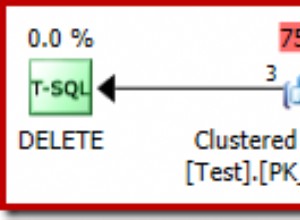Puede haber una manera de hacer esto en una selección de SQL, pero se me escapa. Sin embargo, logré hacerlo con una función almacenada. Esto es lo que hice para mis pruebas:
create table work
(id integer, start_date date, end_date date);
insert into work values (1, '2011-01-01','2011-02-02');
insert into work values (1, '2011-02-02','2011-04-04');
insert into work values (1, '2011-06-06','2011-09-09');
insert into work values (2, '2011-01-01','2011-02-02');
insert into work values (2, '2011-02-02','2011-03-03');
create or replace function get_data() returns setof work as
$body$
declare
res work%rowtype;
sd date := null;
begin
for res in
select
w1.id,
case when exists (select 1 from work w2 where w1.id=w2.id and w2.end_date=w1.start_date) then null else w1.start_date end,
case when exists (select 1 from work w2 where w1.id=w2.id and w2.start_date=w1.end_date) then null else w1.end_date end
from
work w1
order by
id, start_date, end_date
loop
if res.start_date is not null and res.end_date is not null then
return next res;
elsif res.start_date is not null then
sd := res.start_date;
elsif res.end_date is not null then
res.start_date := sd;
return next res;
end if;
end loop;
return;
end;$body$
language 'plpgsql';
Entonces
select * from get_data() order by id, start_date;
devolvió este resultado:
id | start_date | end_date
----+------------+------------
1 | 2011-01-01 | 2011-04-04
1 | 2011-06-06 | 2011-09-09
2 | 2011-01-01 | 2011-03-03
(3 rows)
que es, creo, lo que buscas.




